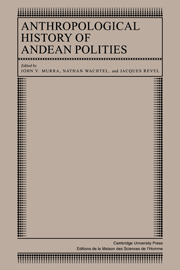Book contents
Preface
Published online by Cambridge University Press: 05 October 2010
Summary
In recent years studies of Andean civilizations by native scholars have flourished in the Andean homelands. Overseas scholars have also lent a hand. Although events in all five Andean republics have warranted curiosity about current developments, the more notable feature of this scholarship has been the growing number of inquiries about the Andean achievement before 1532. The dense populations in a precapitalist society, the remarkable productivity of high-altitude crops and the effect of high-altitude biology, unparalleled textile arts and the vast installations for weaving manufactures, the native perception and use of the southern sky, religious and political symbolism – all of these are privileged topics of current scholarly concern.
Beyond the academic community, many others have become active in defense of the Andean patrimony. Andean camelids and their pastures, the cultivation and use of the coca leaf, the terracing and irrigation of the mountainsides – all these are threatened by foreign intervention. Another expression of this defense is a growing preoccupation with the literary future of the Aymara and Quechua languages, spoken by some 10 million citizens of the five republics, at a time when the mass media have discovered that these speakers are also a market.
In 1984, the Facultad Latino-Americana de Ciencias Sociales of Quito began to offer a two-year program leading to a master's degree in Andean history – an initiative without precedent. Graduates of universities in all five Andean republics, and some from elsewhere, applied; and about thirty received scholarships supporting a year of formal class work with an international faculty drawn from three continents. A second year of thesis research in the field or the archives will follow.
- Type
- Chapter
- Information
- Anthropological History of Andean Polities , pp. ix - xPublisher: Cambridge University PressPrint publication year: 1986



